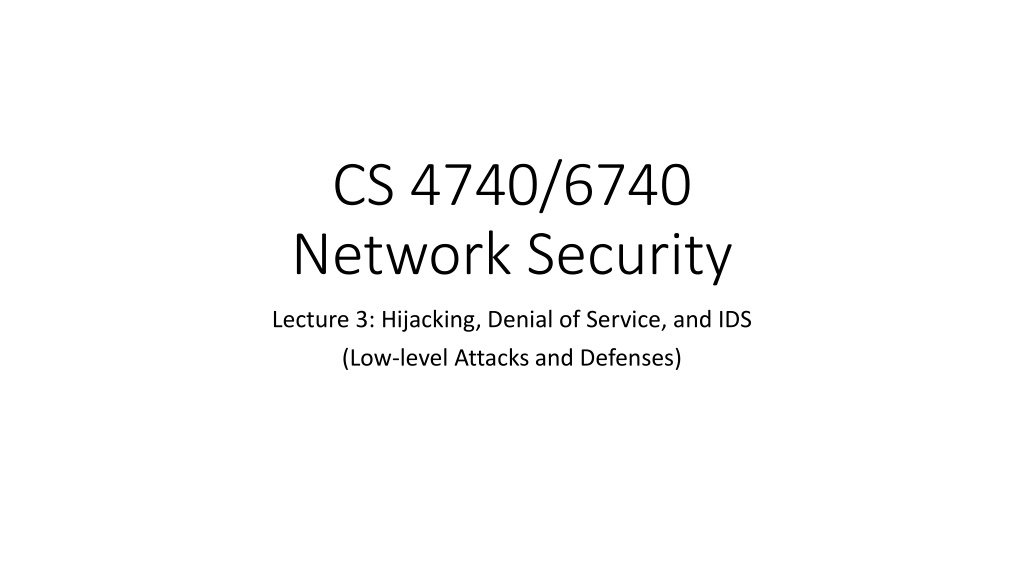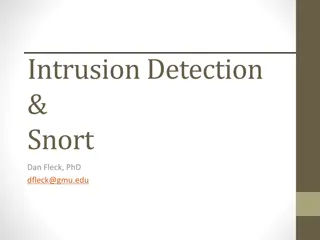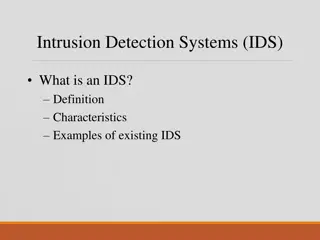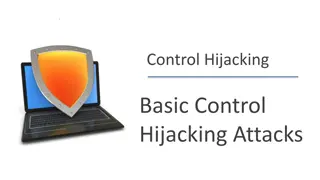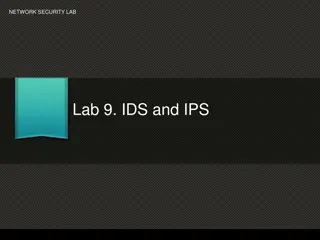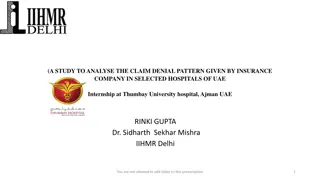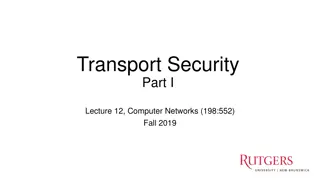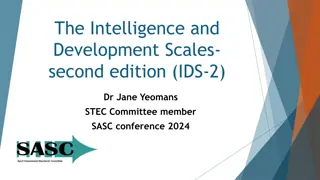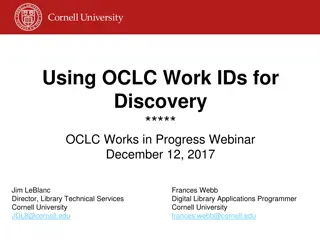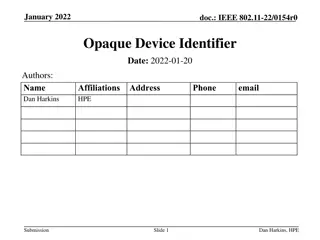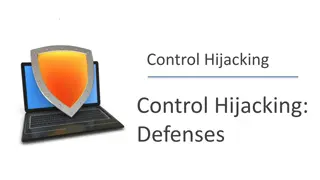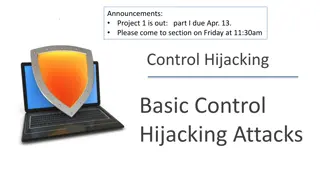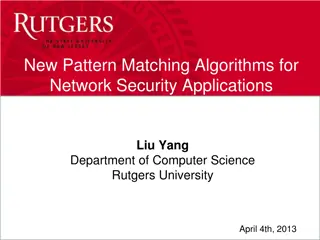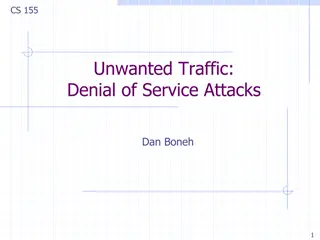Understanding Network Security: Hijacking, Denial of Service, and IDS
This content delves into the concepts of spying and hijacking in network security, covering topics such as eavesdropping on packets, injecting packets into streams, denial of service attacks, and defense mechanisms like firewalls and IDS. It explores low-level attacks and defenses, including ARP cache poisoning, MAC flooding, TCP connection hijacking, attacker goals, threat models, the link layer functions, Address Resolution Protocol (ARP) usage, and practical ARP examples in network scenarios.
Download Presentation

Please find below an Image/Link to download the presentation.
The content on the website is provided AS IS for your information and personal use only. It may not be sold, licensed, or shared on other websites without obtaining consent from the author. Download presentation by click this link. If you encounter any issues during the download, it is possible that the publisher has removed the file from their server.
E N D
Presentation Transcript
CS 4740/6740 Network Security Lecture 3: Hijacking, Denial of Service, and IDS (Low-level Attacks and Defenses)
Todays Topics Spying and Hijacking How to eavesdrop on other people s packets How to inject your own packets into someone else s stream Denial of Service Availability attacks using layer 3, 4, and 5 protocols Defenses? Firewalls and IDS Preventing and detecting attacks on the network Stateless, stateful, and adaptive methods
Spying and Hijacking ARP Cache Poisoning MAC Flooding TCP Connection Hijacking
Attacker Goals and Threat Model Switched Ethernet network Local attacker on the LAN Attacker may send arbitrary packets Internet Router 192.168.0.1 00:AA:BB:CC:00:11 192.168.0.10 01:02:03:04:05:06 I wanna spy on those packets but how? Switch 192.168.0.2 00:11:22:33:44:55 192.168.0.11 1A:2B:3C:4D:5E:6F 192.168.0.255 FF:00:FF:00:FF:FF
The Link Layer Application Presentation Session Transport Network Data Link Physical Functions: Send blocks of data (frames) between physical devices Perform media access control (MAC) Detecting/recovering from collisions and bit errors Layer 2.5 feature Mapping from network addresses to hardware addresses
Address Resolution Protocol A mapping is needed between IP and physical (MAC) address Dynamically established using the Address Resolution Protocol (ARP) Broadcast protocol implemented at the link layer Considered to be a layer 2.5 protocol Used by Ethernet, 802.11, many other link layer protocols with IPv4 Message types: who-has requests Who has IP 192.168.0.2? is-at replies 00:01:2D:00:5F:CC has IP 192.168.0.2 Problem: No binding between ARP messages and sender identity In other words, no authentication
ARP Example Internet 192.168.0.10 is-at 01:02:03:04:05:06 Router 192.168.0.1 00:AA:BB:CC:00:11 192.168.0.10 01:02:03:04:05:06 Src: 192.168.0.11 Dst: 192.168.0.10 IP 192.168.0.11 1A:2B:3C:4D:5E:6F who-has 192.168.0.10? Src: 1A:2B:3C:4D:5E:6F Src: 1A:2B:3C:4D:5E:6F Dst: ??? Dst: 01:02:03:04:05:06 Eth. Eth.
ARP Example 8.8.8.8 Internet 192.168.0.1 is-at 00:AA:BB:CC:00:11 Router 192.168.0.1 00:AA:BB:CC:00:11 192.168.0.10 01:02:03:04:05:06 Src: 192.168.0.11 Dst: 8.8.8.8 IP 192.168.0.11 1A:2B:3C:4D:5E:6F who-has 192.168.0.1? Src: 1A:2B:3C:4D:5E:6F Src: 1A:2B:3C:4D:5E:6F Dst: ??? Dst: 00:AA:BB:CC:00:11 Eth. Eth.
ARP Cache Poisoning Each host on the LAN maintains a cache of IP MAC mappings An attacker can poison ARP caches by spoofing ARP packets Poisoning injecting false information into a data store Spoofing forging the source of a packet Possible attacks: Confidentiality attacker can inspect packets before forwarding them on Integrity attacker may be able to modify packets in-flight Availability attacker can simply drop packets
ARP Poisoning Example 8.8.8.8 Internet 192.168.0.1 is-at 00:AA:BB:CC:00:11 Router 192.168.0.1 00:AA:BB:CC:00:11 Attacker can now observe, modify, or drop packets generated by the target 192.168.0.10 01:02:03:04:05:06 192.168.0.1 is-at FF:00:FF:00:FF:FF 192.168.0.11 1A:2B:3C:4D:5E:6F 192.168.0.255 FF:00:FF:00:FF:FF who-has 192.168.0.1?
Gratuitous ARP Internet Common optimization Preemptively send is-at replies to set the caches of neighboring machines No need to wait for who- has requests OK. Thanks :) 192.168.0.13 is-at 10:11:2F:00:00:FF Great!
Abusing Gratuitous ARP Internet Router 192.168.0.1 00:AA:BB:CC:00:11 192.168.0.1 is-at FF:00:FF:00:FF:FF 192.168.0.255 FF:00:FF:00:FF:FF
Key Issues Why does the ARP cache poisoning vulnerability exist? Lack of authentication Any host on the LAN can claim to own any IP address Data race Attacker tries to outrun to legitimate response and poison the target
DHCP Poisoning Internet DHCP Offer Src: 192.168.0.1 Dst: 255.255.255.255 Attacker can become the gateway and DNS for the target DHCP Offer Src: 192.168.0.255 Dst: 255.255.255.255 Router 192.168.0.1 00:AA:BB:CC:00:11 DHCP Server 192.168.0.10 01:02:03:04:05:06 192.168.0.255 FF:00:FF:00:FF:FF DHCP Discover Src: 0.0.0.0 Dst: 255.255.255.255 192.168.0.11 1A:2B:3C:4D:5E:6F
Tools and Defenses Many link layer attack tools exist arping basic tool for generating ARP messages (analogous to ping) arpspoof (dsniff) $ arpspoof -t [victim s IP] [gateway s IP] Combine with sslstrip to implement SSL MITM attacks ettercap comprehensive package for MITM attacks Defending against link layer attacks Monitoring arpwatch passively monitors observed IP MAC pairings and generates alerts DHCP snooping Static/sticky ARP cache entries Compartmentalization, e.g. VLANs
DHCP Snooping Snoop Table DHCP Discover IP MAC 192.168.0.10 01:02:03:04:05:06 Router DHCP Offer 192.168.0.1 00:AA:BB:CC:00:11 192.168.0.1 00:AA:BB:CC:00:11 192.168.0.11 1A:2B:3C:4D:5E:6F DHCP Server 192.168.0.10 01:02:03:04:05:06 192.168.0.1 is-at FF:00:FF:00:FF:FF Stop 192.168.0.11 1A:2B:3C:4D:5E:6F 192.168.0.255 FF:00:FF:00:FF:FF DHCP Discover
Virtual LANs Virtual Local Area Networks (VLANs) partition a physical network into separate broadcast domains Port-based configuration Ports 1-4 VLAN 1 Ports 5-16 VLAN 2 Tagging MAC:1, MAC:2, MAC3 VLAN 1 * VLAN 2 Compartmentalization enforced at the switch Old approach manually configure switches New approach Software Defined Networks (SDN)
What About IPv6? ARP and DHCP designed for IPv4 networks IPv6/ICMPv6/DHCPv6 should fix these poisoning attacks right? Wrong :( ICMPv6 includes a Neighbor Discovery Protocol (NDP) Almost exactly the same as ARP By default, no authentication :( ICMPv6 also includes a Router Redirect messages Used to tell hosts about more efficient routes to the gateway May be spoofed to redirect a victim towards an attacker Mitigations: Secure Neighbor Discovery Protocol (SEND) extension to IPv6 protocol suite Uses Cryptographically Generated Addresses (CGAs) instead of MAC Relies on an RPKI to validate CGAs
MAC Flooding Modern Ethernet switches make attacks more difficult Passive interception is no longer possible (vs. Ethernet hubs) DHCP Snooping binds IP MAC However, switches have limited resources Content Addressable Memory (CAM) stores MAC port binding Size of the CAM is limited Attack: flood the network with is-at replies, overflow the MAC How do switches typically respond to this? Revert to old-school broadcast model
Towards Connection-Oriented Protocols ARP and DHCP are broadcast protocols No authentication of sources or destinations As we ll see, other ICMP and UDP-based protocols are also vulnerable Connection-oriented protocols are supposed to fix this Connections include some notion of message authenticity E.g. TCP has random sequence numbers and a three-way handshake Question: do TCP connections solve the authentication problem?
The Transport Layer Application Function: Demultiplexing of data streams (port numbers) Optional functions: Creating long lived connections Authenticating packets in the stream Reliable, in-order packet delivery Error detection Flow and congestion control Fairly sharing resources between hosts Presentation Session Transport Network Data Link Physical
Transmission Control Protocol Reliable, in-order, bi-directional byte streams Port numbers for demultiplexing Virtual circuits (connections) Flow control Congestion control, approximate fairness 0 4 16 31 Source Port Destination Port Sequence Number Acknowledgement Number Flags Checksum HLen Advertised Window Urgent Pointer Options
Connection Setup and Flags Why do we need connection setup? To establish state on both hosts Most important state: sequence numbers Count the number of bytes that have been sent Initial value chosen at random Random initial sequence numbers are a form of authentication Important TCP flags (1 bit each) SYN synchronization, used for connection setup ACK acknowledge received data FIN finish, used to tear down connection RST unrecoverable error, immediately terminate the connection
Three Way Handshake Choose SeqS at random Choose SeqC at random Client Server At this point, only the client and server should know SeqC and SeqS
Attacker Goals and Threat Model TCP/IP Internet Attacker is off-path Cannot observe traffic Active attacker May send arbitrary packets Assume the attacker knows IP addresses of targets TCP/IP Connection Server 84.79.0.1:80 I wanna send commands to that server Internet 193.54.34.101:8641 72.80.02.01
Attack Strategies Send a FIN packet? Triggers a multi-packet, graceful shutdown Send a RST packet? Only works if you can guess both ports and the seq/ack numbers ??? Server 84.79.0.1:80 RST seq=? ack=? Src: 84.79.0.1:80 Dst: 193.54.34.101:? I wanna kill that connection! FIN/ACK FIN Internet ??? 193.54.34.101:8641 72.80.02.01
Guessing Sequence Numbers The security of TCP connections relies on the randomness of the initial sequence numbers (ISNs) If an attacker knows the sequence numbers, they can spoof packets Problem: many OSs used to have low-entropy ISN generators Typically seeded by the current time RFC793 increase the ISN by 1 every 4 microseconds Windows NT 4.0 ISN = ms * 10 % 2^32 Attacker can measure the victim s ISN generators NTP query Repeatedly open connections to known services like HTTP, FTP, echo, etc.
TCP RST Attack Server port is typically known, client port must be guessed Older OSs accepted a wide range of plausible seq/ack numbers with RST Modern OSs are more conservative Seq. must be reasonable Ack. must be within the sender s window Server 84.79.0.1:80 Okay, connection closed. RST ?????? Internet ??? 193.54.34.101:8641 72.80.02.01
TCP Connection Hijacking RST attacks enable DoS, but not packet injection Attackers can hijack TCP connections by: 1. Silencing one participant (A) 2. Sending spoofed packets to the other participant (B) If B accepts a spoofed packet, the connection becomes desynchronized Why is it useful to silence one participant? A may RST the connection if they observe a desynchronization or unsolicited packets
rsh Connection Hijacking Example Remote shell (rsh) was the predecessor to ssh Typically allowed connections from a preconfigured list of trusted hosts Attacker goal: spoof a TCP connection from a trusted host Finish login, redirect stdout/stderr to /dev/null, create a new account for the attacker, etc. Server 84.79.0.1:514 Make many TCP connections, measure initial sequence Src: 193.54.34.101:666 Src: 193.54.34.101:666 SYN seq=1 ack=0 ACK seq=2 ack=guess Make sure the trusted host is offline, or DoS them number distribution Dst: 193.54.34.101:514 Dst: 193.54.34.101:514 SYN/ACK ACK Internet Trusted Host 193.54.34.101 72.80.02.01
Modern TCP Modern OSs choose ISNs purely at random This makes off-path hijacking attacks extremely difficult Does this mean TCP is now secure from spoofing and hijacking? No. On-path attackers still see everything, no guessing required May drop, modify, or inject packets at will This is why we need IPSEC, TLS, etc.
Denial of Service Reflection/Amplification: Smurf, NTP, DNS SYN Floods Application Floods
Attacker Goals and Threat Model Off-path attacker on the Internet Active attacker who may send arbitrary packets Goal is to reduce the availability of the victim I wanna knock those servers offline but how? Servers 128.91.0.* Internet 192.168.0.255
DoS Attack Parameters 1. How much bandwidth is available to the attacker? Can be increased by controlling more resources Or tricking others into participating in the attack 2. What kind of packets do you send to victim? Minimize effort and risk of detection for the attacker While also maximizing damage to the victim
Exploiting Asymmetry Example of a Distributed Denial of Service Attack (DDoS) Most DDoS is fueled by botnets Networks of infected machines controlled by the attacker Some DDoS is fueled by volunteers E.g. Anonymous and Low Orbit Ion Canon (LOIC) 10 Mbps 1 Mbps 1 Mbps 10 Mbps Server 128.91.0.1 Internet 192.168.0.255
The Smurf Attack 10.7.0.0 10.7.0.0 10.7.0.253 10.7.0.254 Broadcast request is forwarded to all hosts in the /24 PING Request Src: 128.91.0.1 Dst: 10.7.0.255 Server 128.91.0.1 Internet 192.168.0.255
Why Does Smurfing Work? ICMP protocol does not include authentication No connections Receivers accept messages without verifying the source Attacker benefits from an amplification factor ??? ?????? =????? ???????? ???? ??????? ???? Smurf amp factor [number of servers that respond to the broadcast]:1
Reflection/Amplification Attacks Smurfing is an example of a reflection or amplification DDoS attack Fraggle attack also relies on broadcasts for amplification Send spoofed UDP packets to IP broadcast addresses on port 7 (echo) and 13 (chargen) echo 1500 bytes/pkt requests, equal size responses chargen -- 28 bytes/pkt request, 10K-100K bytes of ASCII in response Amp factor echo [number of hosts responding to the broadcast]:1 chargen [number of hosts responding to the broadcast]*1000:1
DNS Reflection Attack Spoof DNS requests to many open DNS resolvers DNS is a UDP-based protocol, not authentication of requests Open resolvers accept requests from any client E.g. 8.8.8.8 and 8.8.4.4 February 2014 25 million open DNS resolvers on the Internet 64 byte queries generate large responses Old-school A record query maximum 512 byte response EDNS0 extension ANY record query 1000-6000 byte response E.g. $ dig ANY isc.org Amp factor ~100:1 Attackers have been known to register their own domains and install very large records just to enable reflection attacks! March 2013: Spamhaus DDoSed at 300 Gbps via DNS reflection
NTP Reflection Attack Spoof requests to open Network Time Protocol (NTP) servers NTP is a UDP-based protocol, not authentication of requests May 2014 2.2 million open NTP servers on the Internet 234 byte queries generate large responses monlist query: server returns a list of all recent connections Other queries are possible, i.e. version and showpeers Amp factor from 10:1 to 100:1 December 2013: various sites DDoSed at 400 Gbps via NTP reflection
Mitigating Amplification Attacks Filter ingress IP broadcasts at the gateway router i.e. drop anything destined to *.*.*.255 Disable non-essential services echo, chargen, NTP, etc. Configure services to only respond to requests from the local LAN If you write a UDP service, authenticate the sources of packets Don t be part of the problem! The behavior of your software and network impacts the well-being of others
DoS Attack Parameters 1. How much bandwidth is available to the attacker? Can be increased by controlling more resources Or tricking others into participating in the attack 2. What kind of packets do you send to victim? Minimize effort and risk of detection for the attacker While also maximizing damage to the victim
Standard DDoS, Revisited What kind of packets do you send to the victim? Ideally, should be connectionless Why? Difficult to spoof TCP connections Should maximize the resources used by the victim SYN Server 128.91.0.1 Internet 192.168.0.255 SYN
TCP SYN Flood TCP stack keeps track of connection state in data structures called Transmission Control Blocks (TCBs) New TCB allocated by the kernel whenever a listen socket receives a SYN TCB must persist for at least one RTO Attack: flood the victim with SYN packets Exhaust available memory for TCBs, prevent legitimate clients from connecting Crash the server OS by overflowing kernel memory Advantages for the attacker No connection each SYN can be spoofed, no need to hear responses Asymmetry attacker does not need to allocate TCBs
Defending Against SYN Floods: SYN Cookies Key idea: avoid storing TCB state on the server until after the three- way handshake is complete What state in the TCB can be recovered from the client s ACK? Source IP and port Destination IP and port Maximum Segment Size (MSS) for the connection Initial Acknowledgement Number from the source Initial Sequence Number (ISN) SYN cookie construction Encode the MSS, a secret, and consistency check into the ISN in the SYN-ACK Verify the secret and consistency check when the ACK is returned Trivially known by the server Guaranteed to be in the ACK
SYN Cookies 0 5 8 31 Sequence Number hash(src_ip, src_port, timestamp, secret) ISN: timestamp MSS Maximum segment size (MSS) Stated by the client during initial SYN, must be remembered by the server Reflect the client s value back through them Limitation: 8-bit MSS must be encoded in 3-bits Validation: did the client really send me a SYN recently? Timestamp: freshness check, prevents replay attacks Cryptographic hash w/ secret key: prevents spoofed packets
SYN Cookies in Practice Advantages Effective at mitigating SYN floods Compatible with all TCP versions Only need to modify the server, no need for client support Disadvantages MSS limited to 3 bits, may be smaller than clients actual MSS Server forgets all other TCP options included with the client s SYN SACK support, window scaling, etc.
What About Filtering? Problems: Problems: 1. The ingress links are still saturated 2. No idea where the attack is coming from 1. Legitimate traffic is still blocked 2. How do you get Tier 1 ASs to install filters for you? Stop Stop Stop Stop Web Server Success! Some of the attack is halted
Problems With Filters Packet filtering is not a viable solution If you install a local filter: Ingress links are still saturated Very hard to distinguish DDoS packets from legitimate requests, since sources are spoofed Remote filters work better, but: You still need to track down the source of the attack You have no ability to force ISPs and ASs to install filters on your behalf
